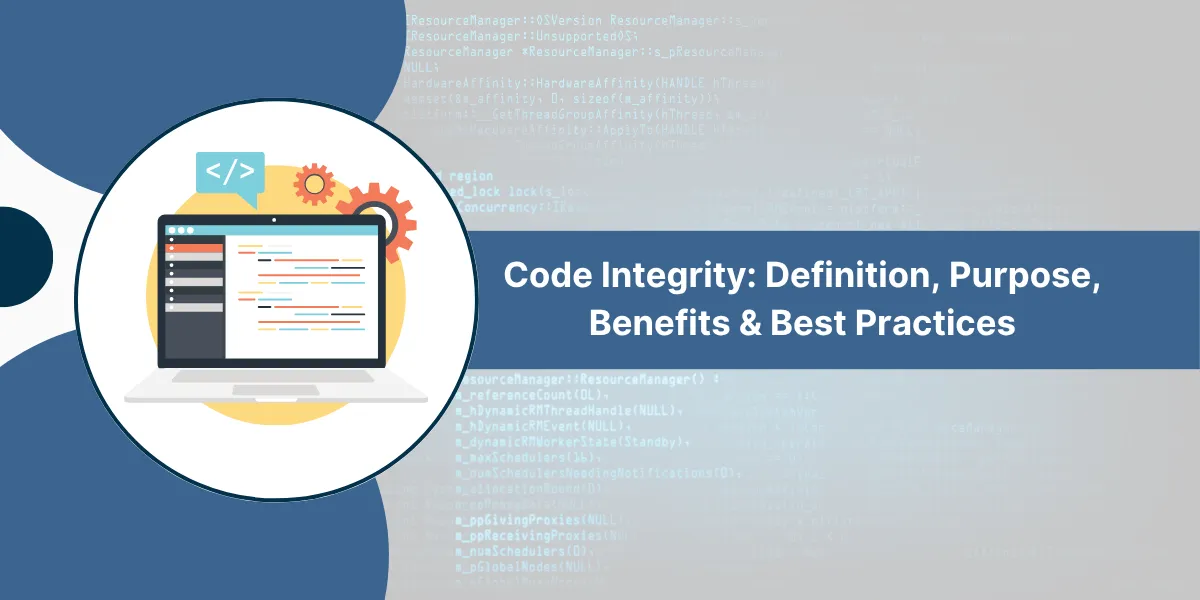What Does Code Integrity Mean?
If we simplify the term, we can learn that code integrity is the security of the application’s code, which should not be changed since the moment it was written until the time it is run. To put it in more detail, code integrity can also be deemed as an indicator that is used in the SDLC. It estimates the compliance or acceptability of source code as it is transferred to quality assurance and is influenced by the respective levels of formal methods applied (if at all) operating on specific code.
Simply put, software integrity is the analysis of the code or code quality. In order to institute that your code is of the best quality, it is necessary to find out the number of probable defects that affect the minimum security and functioning of your application and how often and how effectively the code can be maintained and tested.
Code Integrity: Why It Will Be So Critical by 2025
With time are stakes at face value and ever present, the following set of facts is provided in this sense. It has been proven that cybercrimes will reach $10.5 trillion by 2025, there is another measure that states that cybercrimes will cost $23 trillion by 2027. In addition to that, Gartner also states that 45% of all organizations are expected to undergo software supply chain attacks by the year 2025.
The Rights (Original) passage reveals more discomfiting facts of the imperfection of current codes and their management. This data states that 61% of organizations have secrets leaked between their source code management, and that 80% of GitHub workflows do not meet a baseline of security controls which is again to a more rigorous code’s inspection.
Primary Purposes of Code Integrity
There are several reasons for protecting the code’s integrity:
1. Security Assurance
Protecting software applications from unauthorized modifications, malicious code injections, and tampering throughout the development lifecycle.
2. Quality Assurance
Verifying that code will meet or exceed the requirements in terms of functionality, performance, and maintainability prior to its being operational.
3. Trust and Assurance
Ensuing necessary legal norms and regulations have been met, and people feel comfortable in the software’s reliability and security.
4. Risk Reduction
Reducing the chances of having to deal with all those security impacts, insufficiently functioning systems, and expensive post-deployment problem resolution.
Best Practices Maintains Code Integrity
1. Secure Development Lifecycle Integration
Implementation Strategy:
- Security by Design: From the outset of development, during the initial design phase, one should consider security.
- Threat Modeling: Getting together with the developers to identify threats in the early stages of the development phase.
- Security Requirements: Along with the functional requirements, lay down clear-cut security requirements.
- Regular Security Training: Ensure the development group is kept up-to-date.
2. Automated Code Analysis and Testing
Use static application security testing (SAST) tools to detect vulnerabilities in tandem with a rigorous test strategy:
- Static Code Analysis: Scan code to detect potential security vulnerabilities and codes that are less than ideally developed.
- Dynamic Testing: Runtime analysis to pinpoint security vulnerabilities.
- Unit Testing: Write Unit Tests: Ensure that individual components of the code are tested in isolation to verify their functionality.
- Integration Testing: Check component interaction and data flow security
3. Version Control and Change Management
Essential Practices:
- Branching Strategy: Implement stringent branching policies where every branching action is reviewed
- Commit Signing: Use cryptographical signatures to ensure authorship of issued codes
- Access controls: Restrict and allow users to access repositories based on the user’s roles and responsibilities
- Audit Trails: Keep detailed records or logs of changes in code and their approvals
4. Code Review and Peer Validation
Conduct code reviews to detect possible security issues early in highway development.
Core concepts of the review process include:
- Peer Reviews: Multiple approvals are required before code merges
- Security-Focused Reviews: Security analysis is the prime concern during the review
- Automated Review Tools: It’s good to use some tools for automatic detection of possible security weaknesses
- Documentation Standards: Define practices for documenting code changes
5. CI/CD Security
CI/CD Pipeline Security Considerations:
- Pipeline Integrity: Protect changes to CI/CD configurations from unauthorized modifications.
- Dependency Scanning: Periodic analysis of third-party libraries and components.
- Container Security: Security scanning for containerized applications.
- Environment Isolation: Separate development, testing, and production environments.
6. Secure Coding Standards and Guidelines
Resource Proprietors and Resource Custodians must ensure that secure coding practices, including security training and security reviews, are injected into every phase of the software development life cycle.
Key standards in coding consisting of:
- Input Validation: Perform input data sanitization and validation checks
- Authentication and Authorization: Apply solid access control mechanisms
- Error Handling: Implement error handling that does not leak information
- Cryptographic Practices: Use cryptographic functions correctly for encryption and hashing
7. Supply Chain Security
Protection strategies:
- Vendor Assessment: Assess security aspects of third-party components
- Software Bill of Materials (SBOM): Maintain exhaustive inventories of dependencies
- License Compliance: Comply with legal requirements for the usage of all components
- Vulnerability Monitoring: Monitor more continuously for known vulnerabilities in dependencies
Common Challenges and Solutions
| Challenge | Solution |
| Developer Resistance | Provide comprehensive training and demonstrate value through concrete examples |
| Legacy Code Integration | Implement gradual migration strategies with risk-based prioritization |
| Performance Impact | Optimize tools and processes to minimize development workflow disruption |
| Resource Constraints | Start with high-impact, low-cost measures and scale gradually |
| Tool Proliferation | Integrate tools into unified platforms and establish clear workflows |
Final Thoughts
Business growth requires robust security technologies because threats continue to rise in number. System integrity and trust maintenance depend on the absence of external interference. The combination of code integrity protection with strict security protocols and automated testing and regular audits creates strong asset protection that builds customer trust. These practices decrease security incidents while improving code quality and operational efficiency.
Organizations can fight evolving cyber threats through the implementation of agile processes. Organizations need to build fundamental security systems which must be updated to address new security threats. Code integrity requires continuous assessment and improvement and adaptation to new emerging challenges. A proactive security strategy builds long-term resilience and technological effectiveness for organizational system protection.
Frequently Asked Questions (FAQs)
What is code integrity in software development?
Code integrity is established through keeping the code untouched and valid throughout the life cycle of the software. It ensures that the system would not be tampered with or corrupted during the process of development, deployment, and execution of code. This will result in increased security and reliability of the application.
How does the code integrity affect the security of software?
Code integrity is regarded as a way of protecting software from unauthorized modifications and pesky attacks which hackers make on it. When a software system detects a compromise or alteration in the code, the concerned authorization scheme disables the code.
What three components form code integrity mainly?
The main components of code integrity are certificates, hash values, and controls for verification. These various elements make certain that the code remains true to its core function when it is run. The storage of all logs now becomes a more certain method of checking against defects and their features.
How can code integrity tests be implemented by developers?
Regardless, software developers should also make use of code signing certificates, checksums, or integrity checking tools, along with ways such as regular code reviews and automated testing, to see exactly how well code integrity can be maintained. Version control systems monitor all changes made in the code and keep audit trails.
What are the available tools to verify code integrity?
Several code integrity verification tools widely in use include Microsoft Code Integrity, SGX for Intel, ARM TrustZone, RSA SigNet. Working together, tools like these check code automatically, provide reports, and feature code integrity in many integrated development environments.
What are the advantages of code integrity for business?
From the perspective of the business, the maturity level of code integrity further reduces security risks associated with maintenance costs. By preventing data breach and system failure because of clogged code, it retains customer trust in brands and compliance with security regulations.

Priya Mervana
 Verified Web Security Experts
Verified Web Security Experts
Priya Mervana is working at SSLInsights.com as a web security expert with over 10 years of experience writing about encryption, SSL certificates, and online privacy. She aims to make complex security topics easily understandable for everyday internet users.



